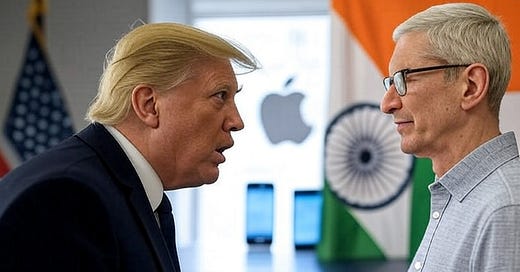Trump Chides Apple CEO: "Don't Build in India"
Trump’s chide to Apple may resonate at home, but it overlooks company’s cost-driven, demand-led, and geopolitically sound pivot to India—and risks being an air-pocket in ongoing U.S.–India trade talks
Karan Bir Singh Sidhu is a retired IAS officer and former Special Chief Secretary, Government of Punjab. He writes at the intersection of geopolitics, economic policy, artificial intelligence, and strategic and tectonic technology shifts, with a focus on India’s evolving global footprint.
Trump Raps Tim Cook Over Apple’s India Manufacturing Strategy
In a candid, if not startling, statement made during his ongoing four-day visit to the Middle East, President Donald Trump publicly chided Apple CEO Tim Cook for expanding iPhone manufacturing in India. Speaking in Doha, Qatar, on May 14, he declared, “I don’t want you building in India,” and advocated instead for Apple to increase its domestic production footprint within the United States. This public nudge adds heat to an already simmering debate over global supply chains, protectionist policies, and the future of tech manufacturing.
The remarks came in the wake of Trump’s impromptu claim—repeated in Riyadh on May 13, following his initial comments made earlier in the Oval Office—that he had helped broker an immediate ceasefire between India and Pakistan, the two nuclear-powered neighbours in South Asia. The assertion reportedly caused additional concern, if not embarrassment or annoyance, in South Block, New Delhi, which houses India’s Ministry of External Affairs. The timing and tone of both remarks introduced an unwelcome diplomatic undercurrent to a discussion otherwise centred on global commerce and technology realignment.
Yet Apple’s pivot to India is not arbitrary—it is a calculated, risk-adjusted move meant to hedge against rising geopolitical tensions with China, diversify sourcing, and leverage India’s growing technical capabilities. With India now producing one in five iPhones globally and output touching $22 billion in FY 2024–25, Apple’s India operations are not just an add-on; they are becoming central to the company’s manufacturing strategy.
India Surges While U.S. Struggles with Scale
While Trump’s appeal may resonate politically, it disregards structural economic realities. Manufacturing iPhones at scale in the United States remains both logistically complex and financially prohibitive. High labour costs, fragmented supply chain infrastructure, and a shortage of skilled electronics workers severely limit the viability of such reshoring efforts.
Conversely, India presents a compelling and cost-effective alternative. Foxconn and Tata Electronics are rapidly expanding production facilities in Tamil Nadu and Assam to meet Apple’s target of shifting 60 million iPhones—28 percent of global shipments—from China to India by 2026. This marks a fundamental rebalancing of Apple’s global manufacturing map, with India emerging as a major production hub.
India’s iPhone Market: Booming Sales and Local Resonance
Apple’s strategic investment in India is also underpinned by surging consumer demand. In the first quarter of 2025 alone, the company sold over 3 million iPhones in India—a record high. This was driven by the popularity of the budget-friendly iPhone 16e and attractive financing schemes tailored to middle-class buyers. For the full year 2024, Apple’s shipments in India rose by 35 percent to 12 million units, making it the tech giant’s fastest-growing market globally.
In stark contrast, China—a former linchpin of Apple’s success—has seen a sharp decline. Sales dropped by 18.2 percent in Q4 2024, amid a resurgent Huawei and growing regulatory constraints on Apple’s AI-based features. Apple’s global market share dipped to 18 percent, reflecting headwinds in its traditional strongholds.
PLI and Policy Tailwinds: India’s Manufacturing Muscle
At the heart of India’s manufacturing success story is the Production Linked Incentive (PLI) scheme. With a budget of ₹1.97 lakh crore ($24 billion), the scheme has already attracted ₹1.46 lakh crore ($13 billion) in private investment. Results are impressive: ₹12.5 lakh crore ($151 billion) in total production, ₹4 lakh crore ($48 billion) in exports, and the creation of 9.5 lakh new jobs, particularly in the electronics and pharmaceutical sectors.
While there are valid concerns about bureaucratic inertia and uneven performance in sectors such as textiles, mobile manufacturing has exceeded expectations. As of April 2025, government subsidies paid under PLI amounted to just over $1 billion—a small price for enabling over $13 billion in committed private capital and a decisive repositioning of India on the global manufacturing map.
Silicon Dreams: Chips, GPUs, and India’s High-Tech Turn
India is not resting on its laurels. It is now pivoting towards high-tech manufacturing, especially in semiconductors and artificial intelligence. Tata’s ₹27,000 crore ($3.2 billion) facility in Assam is poised to produce 48 million chips per day by 2026, targeting sectors like electric vehicles and telecommunications.
Complementing this is the government-backed IndiaAI Mission, with an allocation of ₹10,372 crore, aimed at developing the country’s first AI-capable GPU by late 2025, with mass production slated for 2029. Meanwhile, on May 14, the Union Cabinet approved a new HCL-Foxconn joint venture in Jewar, Uttar Pradesh, with a ₹3,706 crore ($446 million) investment to set up India’s first commercial silicon wafer fabrication unit. This will provide raw material inputs for chip-making, reinforcing India’s ambitions of becoming a full-spectrum semiconductor power.
Together, these initiatives fall under India’s broader $10 billion semiconductor incentive programme, which offers up to 75 percent capital support and complements the PLI scheme’s electronics ecosystem.
Tariffs as Strategy: Trump’s Trade Doctrine and Global Peace Gambit
President Trump’s latest pronouncements must also be viewed in the context of his broader trade strategy, where tariffs serve not just as economic shields but as geopolitical levers. His earlier tariff standoff with China—which now appears to be moving towards resolution, given the 90-day hiatus agreed upon in Geneva—demonstrates his willingness to use trade pressure as a form of calibrated coercion. Trump has frequently asserted that while trade has often been used as a tool of conflict, he may be the first international leader to repurpose it for peace—a claim underscored by his self-proclaimed role in facilitating a ceasefire between India and Pakistan.
This narrative, however bold, arrives even as Indo-U.S. negotiations on a comprehensive bilateral trade pact are gaining momentum. In that context, Trump’s public and unsolicited advice to Apple’s Tim Cook has generated some unease. Nevertheless, observers on both sides hope that it proves to be no more than a passing air-pocket in an otherwise ascending strategic and economic trajectory.
Apple’s Financial Pressures and Regulatory Tightrope
While India offers Apple a manufacturing and growth cushion, the company continues to grapple with intensifying global regulatory and financial pressures. In the European Union, Apple has been ordered to repay €13 billion in taxes to Ireland and faces multiple antitrust investigations under the Digital Markets Act for alleged anti-competitive practices, including restrictions on app stores and payment systems. The United States is following suit, with a 2024 Department of Justice lawsuit accusing Apple of stifling competition in streaming and mobile payments. These legal headwinds have contributed to notable share price volatility: after peaking at $258.40 in December 2024, Apple’s stock declined over 15% year-to-date, averaging $221.29. Despite a modest revenue rise to $391 billion in FY2024, net income dipped 3.4% amid fines and surging R&D costs. Investor confidence has also been shaken—most visibly through Warren Buffett’s strategic move to reduce Berkshire Hathaway’s Apple stake by nearly 60%, selling $133 billion in stock. Against this backdrop, Apple’s India pivot emerges not only as a cost-saving strategy but as a critical hedge against mounting scrutiny in its traditional markets.
Looking Ahead: India’s Ascent and the Road Ahead
Trump’s call to halt iPhone production in India may play well with a domestic audience, but it misreads the global manufacturing calculus. Apple, driven by cost efficiencies, rising Indian consumer demand, and geopolitical insurance, is unlikely to reverse course. Whether Apple will formally comply with Trump’s request—and if so, to what extent—remains to be seen. It is worth noting that Apple still manufactures the majority of its iPhones in China and has no smartphone production facilities in the United States. While it has pledged to hire more workers at home and announced plans to spend $500 billion domestically over the next four years, large-scale iPhone assembly in the U.S. remains economically implausible.
India’s likely response will be measured yet firm—emphasising its credibility as a manufacturing partner and the strategic logic underpinning its production-linked incentive architecture. To New Delhi, this moment is not merely a flashpoint but a first-of-its-kind validation. For the first time, “Make in India” is transmitting a strong and independent international signal of relevance and competitiveness—not just the domestic rhetoric of ‘Atmanirbhar Bharat’.
Yet the balancing act remains delicate. Navigating U.S. protectionism, sustaining investor confidence, and accelerating domestic capacity building will require careful diplomacy. India must continue to walk the fine line between asserting strategic autonomy and attracting global capital, ensuring that “Make in India” and “MAGA” can co-exist without slipping into a zero-sum rivalry.





